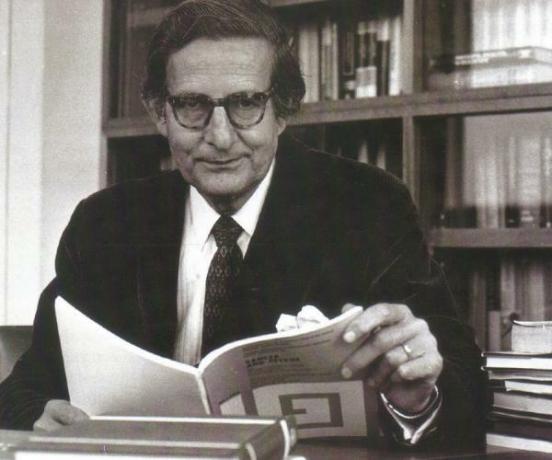
Hans Eysenk is one of the great theorists of personality and temperament of the second half of the 20th century
Temperament is that aspect of the personality that (theoretically) it is based on genetics, that you are born with it; either from birth or even earlier. This is not to say that the temperamental theory says that we do not have aspects of our personality that have been learned. He simply focuses on the "natural", and leaves the "nurturing" to other theorists.
We want to dedicate this Psychology-Online article to Eysenck and other temperament theorists.
Index
- Hans Eyesenck: Biography
- Hans Eysenk theory and personality test
- Eysenk's personality theory: neuroticism
- Relationship between neuroticism and extraversion-introversion
- The psychotic and the Big Five model
- Criticisms of Eysenk's personality theory
- Eyesenck: Books
- Personality theories- other theories
- Other theories of temperament
- Personality theories parallel to Eysenk
Hans Eyesenck: Biography.
Hans Eysenck was born in Germany on March 4, 1916. His parents were actors who divorced when he was only two years old, so Hans was raised by his grandmother. He left home when he was 18, as the Nazis came to power. As a sympathizer of the Jews, his life was in danger.
In England he continued his education and received his BA in psychology from the University of London in 1940. During World War II, he assisted as a hospital emergency psychologist, where he investigated the accuracy of psychiatric diagnoses. The results of these investigations would lead to a lifelong antagonism to the mainstream of clinical psychology.
After the war, he began teaching at the University of London, combining it with his inclusion as director of the department of psychology at the Institute of Psychiatry, associated with the Bethlehem Royal Hospital. Eysenck has written 75 books and about 700 articles, which has established him as one of the most prolific writers in psychology. He retired in 1983 and continued to write until his death on September 4, 1997.

Hans Eysenk theory and personality test.
Eysenck's theory is based primarily on the psychology and genetics. Although he is a behaviorist who considers learned habits as something of great importance, he considers that our differences in personalities arise from our hereditary heritage. Therefore, he is primarily interested in what is usually known as temperament.
Eysenck is of course also a research psychologist. His methods comprise a statistical technique called factor analysis. This technique extracts a number of "dimensions" from a large body of data. If, for example, if we offer a long list of adjectives to a considerable number of people to self-evaluate, we already have a first material for factor analysis.
Eysenk: personality test
The Hans Eysenk test is known as eysenck personality inventory And it works like this: Imagine, for example, a test that includes words like "shy", "introverted", "forward", "wild" and so on. Obviously, shy people tend to score high on the first two words and low on the last two. Extraverted people will do the same in reverse.
Factor analysis extracts dimensions (factors) such as shyness-extroversion of the amount of information. The researcher then examines the data and names the factor with a term such as "introversion-extraversion." There are other techniques that seek to compare in the best possible way the data of several possible dimensions, and others that they even look for "higher" dimensional levels (factors that organize factors, just as headlines organize Subtitle.
Eysenk's personality theory: neuroticism.
Eysenck's original research showed us two main dimensions of temperament: neuroticism and extraversion-introversion.
1. Neuroticism
This is the name Eysenck gave to a dimension that ranges from those normal, calm and collected people to those who tend to be quite "nervous." His research shows that the latter tend to suffer more frequently from a variety of "nervous disorders" that we call neuroses, hence the name of the dimension. But we must point out that he did not mean that those people who scored high on the scale of neuroticism are necessarily neurotic, but are more susceptible to problems neurotic.
Eysenck was convinced that since everyone scored at some point on this dimension from normality to neuroticism, this was a true indicator of temperament; that is, this was a genetically and physiologically supported dimension of personality. Subsequently, he turned to physiological research to search for possible explanations.
The most obvious place to look was the sympathetic nervous system. This is a part of the autonomic nervous system that functions separately from the central nervous system and controls many of our emotional responses to emergency situations. For example, when signals from the brain tell it to do this, the sympathetic nervous systems command the liver to release sugar to be used for energy, slows down the digestive system, opens the pupils, makes the hairs on the skin stand on end, and commands the adrenal glands that release more adrenaline (epinephrine) This disrupts many of the body's functions and prepares the muscles for action. The traditional way of describing the function of the sympathetic nervous system is that it prepares us to "fight or fly."
Eysenck hypothesized that some people have a greater sympathetic response than others. Some are very calm during emergency situations; others feel real panic or other emotions and some others are terrified by minor situations. The author suggests that the latter have a problem of sympathetic hyperactivity, which makes them prime candidates for various neurotic disorders.
Perhaps the most "archetypal" neurotic symptom is panic attack. Eysenck explained panic attacks as something like the high-pitched sound one hears if you hold a microphone close to a speaker: the small sounds that enter the mic are amplified and leave through the speaker and enter the mic again, amplify again and so on until we hear the typical squeak that we loved to produce when we were kids (many electric guitarists use this system to hold notes for long weather.)
Well, the panic attack follows the same pattern: you are moderately frightened by something (crossing a bridge, for example). This situation causes your sympathetic nervous system, which makes you more nervous and therefore more susceptible to stimulation, which makes your system even more attentive, that makes you more nervous and more susceptible... We could say that the neurotic person is responding more to his own panic than to the object that produces the same! I can certainly attest to Eysenck's description, although his explanations remain hypothetical only.
2. Extraversion-introversion
This second dimension is very similar to what Jung said in the same terms and something very similar to our own. understanding under the common sense of the same: shy and calm people versus people thrown forward and even boisterous. This dimension is also found in all people, but its physiological explanation is a bit more complex.
Eysenck hypothesized that extraversion-introversion is a question of balance between "inhibition" and "arousal" in the brain itself. These are ideas that Pavlov used to explain some of the differences found in the stress reactions of his dogs. The excitement it is the awakening of the brain itself; be alert; learning state. The inhibition it is the "sleeping" brain, calm, both in the usual sense of relaxing and in that of going to sleep or in the sense of protecting itself in the case of excessive stimulation. There are people who simply faint from a stimulus that is too powerful. N.T.
Someone who is extroverted, Eysenck said, has a good strong inhibition: when he is faced with traumatic stimulation (such as a crash in a automobile), the extravert's brain becomes inhibited, which means that it becomes "numb," we might say, to trauma and therefore will remember very little has occurred. After the car accident, the extrovert might say that it is as if he had "deleted" the scene and would ask others to remind him of the scene. Since they don't feel the full mental impact of the accident, they could be driving perfectly the next day.
On the other hand, the introvert he has poor or weak inhibition: when there is a trauma, like a car accident, his brain doesn't protect him fast enough; it does not "turn off" at any time. Rather, they are very alert and learn a lot, so that they can remember everything that has happened. They would even say they have seen the accident in "slow motion!" You are very unlikely to want to drive after the accident and may even stop driving forever.
Now, how does this lead to shyness or love between people? Well, imagine that both the extrovert and the introvert get drunk, take off their clothes, and dance naked at a restaurant table. The next morning, the extrovert will ask us what happened (and where his clothes are). When we tell him, he will laugh and start making plans for another party. On the other hand, the introvert will remember each and every mortifying scene of his humiliation and will probably never leave his room. (I'm quite an introvert myself, and once again I support a lot of these experiences in my flesh! Perhaps some of the extroverts reading me right now could tell me if Eysenck describes his experiences as well as me, assuming, of course, that they can remember them.
One of the things Eysenck discovered was that criminals tended to be non-neurotic extroverts. It is logical, if we think about it carefully: it is difficult to imagine someone painfully shy remembering his experiences while he is robbing a Supermarket! It's even harder to imagine someone with panic attacks doing it. But, let's understand that there are many types of crimes other than violent that introverts and neurotics can carry out.

Relationship between neuroticism and extraversion-introversion.
Another thing Eysenck pointed out was the interaction of both dimensions and what this could mean with regard to various psychological issues. He found, for example, that people with phobias and obsessive-compulsive disorders tended to be quite introverted, and people People with conversion disorders (e.g. hysterical paralysis) or with dissociative disorders (e.g. amnesia) tended to be more extroverts.
Let's see the explanation: highly neurotic people over-respond to a threatening stimulus; If they are introverts, they will learn to avoid situations that cause them panic very quickly and abruptly, even to the point of being very afraid of small symbols of those situations; that is, phobias. Other introverts will learn (quickly and abruptly) particular behaviors to control their fears, such as checking things many times or washing your hands countless times throughout the day.
Highly neurotic extroverts, on the other hand, are good at ignoring and forgetting what oversaturates them. They use the classic defense mechanisms, such as denial and repression. They can conveniently forget that painful week, for example, or even "forget" their ability to feel and use their legs.

The psychotic and the Big Five model.
Eysenck came to recognize that although he used a large population for his research, there was a population type that he was not considering. He began to take his studies to the mental institutions of England. When these data were analyzed using the factorial technique, a third significant factor began to emerge, which he called psychoticism.
In the same way as neuroticism, a high score in psychoticism does not necessarily indicate that you are psychotic or that you are doomed to be, simply that you have qualities that are frequently found in psychotics, and that you will probably be more susceptible, in certain settings, to becoming psychotic.
Indeed, as we might imagine, the types of qualities found among high scores in this dimension include a certain recklessness; a disregard for common sense or conventions; and a certain degree of inappropriate expression of emotion. This is the dimension that separates those people who end up in institutions from the rest of humanity.
The Big Five model
Also known as the Big 5 o five factor model, this model adds 3 more dimensions to Eysenk's theories of personality in psychology, which is why personality is defined by the following factors:
- Extraversion-Intraversion
- Openness to experience
- Responsibility
- Amiability
- Neuroticism
Criticisms of Eysenk's personality theory.
Hans Eysenck was a iconoclastic (someone who likes him attack established opinion) He was a vigorous and early critic of the effectiveness of psychotherapy, especially of the Freudian variety. He also criticized the scientific nature of many of the academic varieties of psychology. As a strong behaviorist, he believed that only the scientific method (as he understood it) could give us an accurate understanding of human beings. As a statistician, he believed that mathematical methods were essential. As a physiologically oriented psychologist, he argued that physiological explanations were the only valid ones.
Of course we can argue with him on all these points: phenomenology and other quantitative methods are also considered scientific by many authors. Some things are not easily reducible to numbers, and the factorial analysis in particular, it is a technique that not all statisticians approve of. And even it is certainly debatable that all things have a physiological explanation (even B.F. Skinner, the arch behaviorist, thought in terms of conditioning - psychological process - that in terms of physiology)
And yet his descriptions of different types of people, and how they can be understood physically, resonate to us as particularly true. And most parents, teachers, and child psychologists are quite supportive of the idea that children have differences. constitutional in their personalities that arise from birth (and even earlier), and that no further re-education will be able to remove. Although I'm not personally a behaviorist, I hate statistics, and I'm more culture-oriented than biology-oriented, I agree with the basics of Eysenck's theory. Of course you must make your own theoretical reflection.

Eyesenck: Books.
It is very difficult to choose only a few books by Eysenck, however, to correctly summarize his personality theories in psychology, we can highlight the following works by him:
- The basics of his theory are probably further explained in The Biological Basis of Personality (1967) but it is a bit complex.
- His most "popular" book is Psychology is about People (1972)
- If you are interested in psychoticism, try Psychoticism as a Dimension of Personality (1976)
- And if you want to understand their point of view on criminals, refer to Crime and Personality (1964)
- His unusual, but interesting theory about personality and cancer and heart disease is summarized in Psychology Today (December, 1989)
Personality theories - other theories.
The section on personality types, including temperament, is as old as psychology. In fact, it is quite older. The ancient Greeks, to follow the obvious example, gave it a lot of attention and decided to name two dimensions of temperament that led to four "types", based on the type of fluids (called humors), depending on whether they had excess or default. This theory was quite popular in the Middle Ages.
- The type sanguine he is cheerful and optimistic; a nice person to be with and comfortable with his work. According to the Greeks, this type has an abundant amount of blood available (hence the name sanguine, from Latin sanguis for blood) and therefore is a subject characterized by an always healthy appearance, including cheeks red.
- The type choleric it is characterized by an important soon; by an immediate temperament in his expression, usually of an aggressive nature. The name comes from bile (a substance secreted by the gallbladder to help digestion) The physical characteristics of the choleric person include a yellowish complexion and tense muscles.
- Then we have the temperament phlegmatic. These people are characterized by their slowness, laziness and inactivity. Obviously, the name comes from the word phlegm, which is the mucus that we extract from our lungs when we suffer from the flu or a lung infection. Physically, these people are seen as cold and distant, and shaking hands is like shaking them with a fish.
- Finally, we have the temperament melancholic. These people tend to be sad and even depressed and have a pessimistic view of the world. The name has been adopted as a synonym for sadness, but it comes from the Greek words for black bile. Of course, we don't know what the Greeks meant by this. But, presumably, the melancholic person must have had a lot of this!
These four types are really the pillars of two distinct lines: temperature Y humidity. Blood people are warm and humid. Angry people are warm and dry. Phlegmatics are cold and damp, and melancholic ones are cold and dry. There were even theories that suggested that different climates were related to different types, so that Italians (land hot and humid) were sanguine, the Arabs (hot and dry) angry, the Russians (cold and dry) melancholic, and the English (cold and wet) phlegmatic.
What should surprise you is that this theory, based on so little, currently has influence on various modern theorists. Adler, for example, relates these guys to his four personalities. But, even more related to ours, Ivan Pavlov, a true world famous in conditioning, used humors to describe the personalities of his dog.
One of the things Pavlov tried with his dog was the conflict conditioning (ringing a bell signaling the food at the same time as another ringing signaling the end of it) Some dogs learned well, and maintained their behavior. Others got angry and barked like mad. A few more lay down to sleep and some jumped and squirmed like they had a nervous breakdown. Of course, I don't need to tell you what kind of temperament each one has!
Pavlov thought that he could explain these personality types through two dimensions: on the one hand is the overall level of stimulation (called arousal) that the brains of the dogs had available. On the other, the ability of these brains to change their levels of stimulation; namely, the level of inhibition that their brains had available.
- A lot of stimulation and good inhibition: sanguine.
- Much stimulation and poor inhibition: choleric.
- Not much stimulation and considerable inhibition: phlegmatic.
- Not much stimulation and poor inhibition - melancholic.
Stimulation would be something like warmth and inhibition would be something like humidity. All of this was the inspiration for Eysenck's theory.
Other theories of temperament.
There are literally dozens of other attempts to discover basic human temperaments. Next, we will look at some of the best known theories.
Your body and your personality
In the '50s, William Sheldon (born 1899) became interested in the various human body varieties. He developed a very precise measurement system that summarized body silhouettes with three numbers. These referred to how precisely you fit these three "types":
- EctomorphicSlender, usually tall people with long arms and legs and fine features.
- Mesomorphic: people of lineage. With broad shoulders and good muscles.
- Endomorphic: chubby people, like "sheep".
We should note that these three "types" have a good personal stereotype associated with them, so the author decided to test the idea. So it came up with three other numbers, this time designed to see how precisely you fit into these three personality "types":
- Cerebrotonic: Nervous, relatively shy and usually intellectual types.
- Somatotonic: Active, physically fit and energetic guys.
- Viscerotonics: Sociable types, lovers of food and physical comfort.
This author theorized that the connection between the three physical types and the three personality types was of embryogenic origin. In the early stages of our prenatal development, we are made up of three sheets or "layers": the ectoderm or outer layer, which becomes the skin and nervous system; the mesoderm or middle layer, which will become muscle; and the endoderm or inner layer, which will become the viscera.
Some embryos show further development in one layer or another. This author suggests that those with high ectodermal development will be ectomorphic, with more skin surface area and greater neurological development (including the brain; therefore cerebrotonic) Those with a great development of the mesoderm, will be mesomorphic, with a large amount of musculature (or body; that is, somatotonic) And those with a great endodermal development, will be endomorphic, with a good visceral development and a great attraction towards food (viscerotonics) and thus establishes its measurement.
Now, note that I used "types" in quotes above. This is an important point: this author considers these two groups of three numbers as dimensions or features, not as types (classification) at all. In other words, we are more or less ecto, meso, AND endomorphic, as well as more or less brain, somato, AND viscerotonic.
Thirty-five Factors
Raymond Cattell (born 1905) is another prolific theorist-researcher like Eysenck who made extensive use of the factor analysis method, albeit in a somewhat different way. In his early investigations, he isolated 16 personality factors, which he grouped together in a test called, of course, 16PF.
Subsequent research added seven more factors to the list. Later research even added twelve "pathological factors"using variables extracted from the MMPI (Minnesota Multiphasic Personality Inventory)
A "second order" factor analysis of the total of 35 factors showed eight more "deep" factors. These are, in order of strength, the following:
- QI. Exvia (Extraversion)
- QII. Anxiety (Neuroticism)
- QIII. Courtesy ("Cortical alert", practical and realistic)
- QIV. Independence (very lonely guys)
- QV. Discretion (socially prudent and insightful types)
- QVI. Subjectivity (distant and does not fit well)
- QVII. Intelligence (CI)
- QVIII. Good breeding (stable, docile)
Twin babies
Arnold buss (born 1924) and Robert Plomin (born 1948), both University of Colorado workers in their time, took a different approach: assuming some aspects of our behavior or personality have a genetic or birth basis, we will find these traits more clearly in children than in Adults.
So Buss and Plomin decided to study the infants. In addition, since identical twins had the same hereditary load, we should see in them those aspects of the personality genetically based. If we compare identical twins with fraternal twins (say, genetically speaking as simply brothers or sisters or twins, as they are also known), we can extract things that are more genetic than those others due more to the baby's learning in its first months.
Buss and Plomin urged mothers of twin babies to fill out a questionnaire about their babies' behavior and personality. Some of the babies were identical and some were twins. Using a technique similar to factor analysis, they separated those descriptions that seemed more genetic from those that seemed more based on learning. They found four dimensions of temperament:
- Emotionality-impassiveness: How emotional or excitable were the babies? Some reacted with a great deal of stress, fear and anger and others did not. This was the strongest dimension they found.
- Sociability-separationHow much did the babies enjoy or avoid contact and interaction with other people? Some very sociable babies and some very lonely.
- Activity-lethargyHow vigorous, how active, how energetic were the babies? In the same way as adults, some babies were always active, moving around, busy, and others were not.
- Impulsivity-deliberativeness: How fast did babies switch from one activity to another? Some people act immediately on your wishes; others deliberate and think more about their actions before carrying them out.
The last dimension is the weakest of all, and in the original investigation it was only found in males. Of course, this does not mean that there are no impulsive or hesitant women; it just seems to be that they learn her style, whereas boys in one way or another seem to come into the world straight from their mother's belly. But the latest research by these authors demonstrated the occurrence of this dimension also in girls, although not so strongly. It is interesting to note that impulse problems such as attention deficit and hyperactivity are more in men than in girls, and this is seen in the fact that while girls are taught to sit up straight and show attention, some boys cannot do it.
The Magic Number
In the last couple of decades, a considerable number of researchers and theorists have concluded that five is the "magic number" for dimensions of temperament. The first version, called The Big Five, was introduced in 1963 by Warren norman. It consisted of a review and update of a technical report of the Air Forces of AND. C. Tupes Y R. AND. Crystal, who in turn had re-evaluated Cattell's original 16 Personality Factors research.
But it wasn't until R. R. McCrae Y P. T. Costa, Jr. they presented the version of him, called the Fifth Factor Theory in 1990, when the idea of individual differences really took hold in community research. When they introduced their NEO Personality Inventory, many people believed, and still think, that we had finally reached the Promised Land!
The following are the five factors along with some defining adjectives:
- Extraversion
Adventurous
Assertive
Frank
Sociable
Talker (communicator)
Vs. Introversion
Still
Reserved
Shy
Unsociable
- Sympathy (agreeableness)
Altruistic
Gentile
Nice
Nice
Warm
- Diligence (Conscientiousness)
Competent
Obedient
Methodical
Responsable
Thorough, thorough
- Emotional stability (Norman)
Calmed down
Relaxed
Stable
Vs. Neuroticism (Costa and McCrae)
Angry
Anxious
Depressed
- Culture (Norman) or Openness to Experience (Costa and McCrae)
Worship
Aesthetic
Imaginative
Intellectual
Open
THE PAD MODEL
Albert mehrabian has a three-dimensional temperament model that has been well received. He is based on his three-dimensional model of emotions. In this sense, the author theorizes that practically any emotion can be described with these three dimensions: pleasure-displeasure (P), stimulation-no stimulation (A) and dominance-submission (D).
He explains that although we vary from one extreme to another in various situations and times in these three dimensions, some of us are more likely to respond in one way or another; that is, we have a temperamental predisposition to certain emotional responses. In English, the author uses the same initials for the different temperaments: Pleasure-displeasure trait; Stimulation trait and Dominance-submission trait.
The "P" means that, in general, you experience more pleasure than unpleasure. It is positively related to extraversion, affiliation, good parenting, empathy, and achievement; and negatively with neuroticism, hostility and depression.
The "A" means that you respond more strongly to complex, changing or unusual situations. It relates to emotionality, neuroticism, sensitivity, introversion, schizophrenia, heart disease, eating disorders, and much more.
The "D" suggests that you feel in control over your life. It is related (in its positive pole) with extraversion, assertiveness, competitiveness, affiliation, social skills and education. At its negative extreme with neuroticism, tension, anxiety, introversion, conformity and depression.

Theories of personality parallel to Eysenk.
Even though you might feel a bit saturated with all these various theories, in fact, personality theorists are more encouraged than discouraged: it is fascinating. for us to see how all these different theorists that arise many times from different directions, can manage to deal with very similar groups of dimensions temperamental.
First, each theorist places the Extraversion-introversion and of Neuroticism / StabilityEmotional / Anxiety within their lists. Few personologists have doubts regarding these.
Eysenck adds that of Psychoticism, which many of his followers have re-evaluated as a suggestive factor of aggressiveness, impulsiveness and tendency to seek sensations. To some extent, this fits with Buss and Plomin's Impulsiveness and could be the opposite of the Big Five's Agreeableness and Consciousness.
The theory of Buss and Plomin fits better with Sheldon's: Cerebrotonics are Emotional (and not Sociable), Somatotonics are Active (and not Emotional), and Viscerotonics are Sociable (and not Active). In other words, the factors of these two models "rotate" slightly on the others.
Cattell's other factors, other than Anxiety and Exvia, are more difficult to place. Discretion sounds like Niceness; Good Education resembles that of Conscience; Independence, perhaps added to that of Intelligence, is a bit like that of Culture. Subjectivity, Courtesy and Independence together could be similar to Eysenck's Psychoticism.
Mehrabian PAD factors are a bit more difficult to check against others, which makes sense considering its different theoretical roots. But we can see that Stimulation is very similar to Neuroticism / Emotionality and that Dominance is not like Extraversion / Sociability. Pleasure seems related to Extraversion without Neuroticism.
We could also take a look at the Jung and Myers-Briggs test: Extraversion and Introversion are obvious. Feeling (vs. Thought) sounds a bit like Niceness. Judgment (vs. Perception) sounds like Consciousness. And Intuition (vs. Sensitivity) sounds a bit like Culture. In any case, it helps us to see that Jung considered these types and functions as essentially genetic; or what is the same, temperamental!
This article is merely informative, in Psychology-Online we do not have the power to make a diagnosis or recommend a treatment. We invite you to go to a psychologist to treat your particular case.
If you want to read more articles similar to Personality Theories in Psychology: Eysenck and other temperament theorists, we recommend that you enter our category of Personality.
Bibliography
- For Sheldon, see The Varieties of Temperament (1942)
- For Cattell The Handbook for the 16 Personality Factors Questionnaire (1970, with Ebert and Tatsuoka)
- For Buss and Plomin, look at Personality: Temperament, Social Behavior, and the Self., Which is where their theories are best summarized.
- For Norman, see "Toward an adequate taxonomy of personality attributes" in The Journal of Abnormal and Social Psychology (1966, pp. 574-583).
- For McCrae and Costa, see Personality in Adulthood (1990) dedicated to research.


